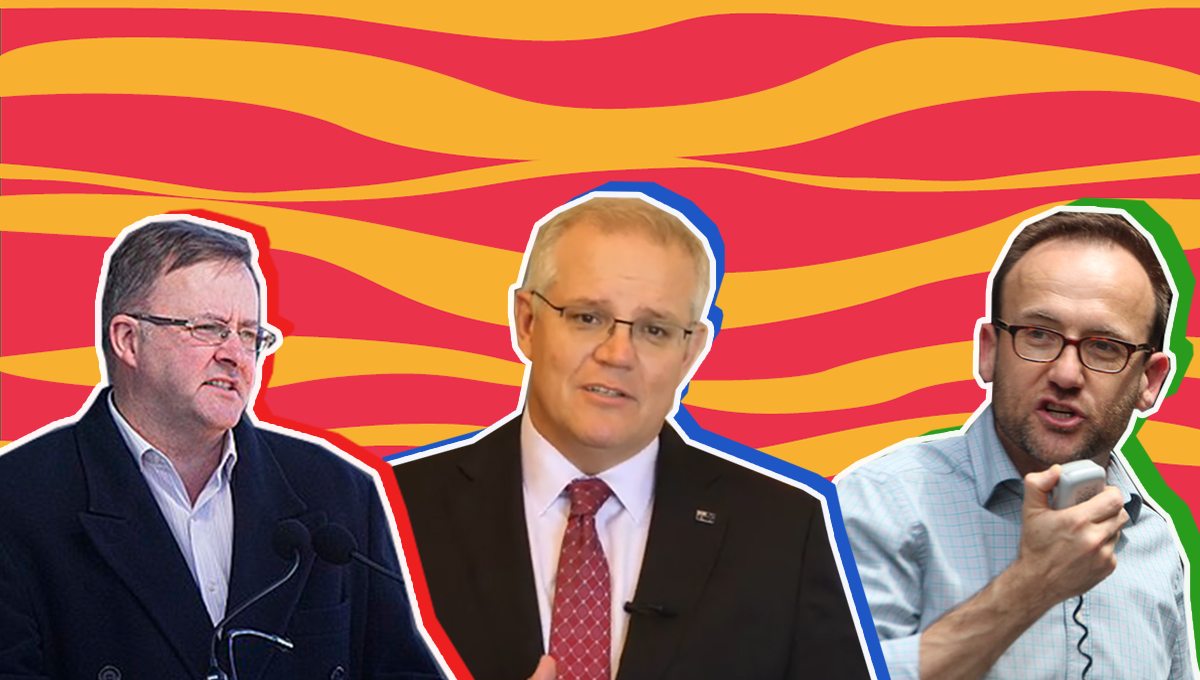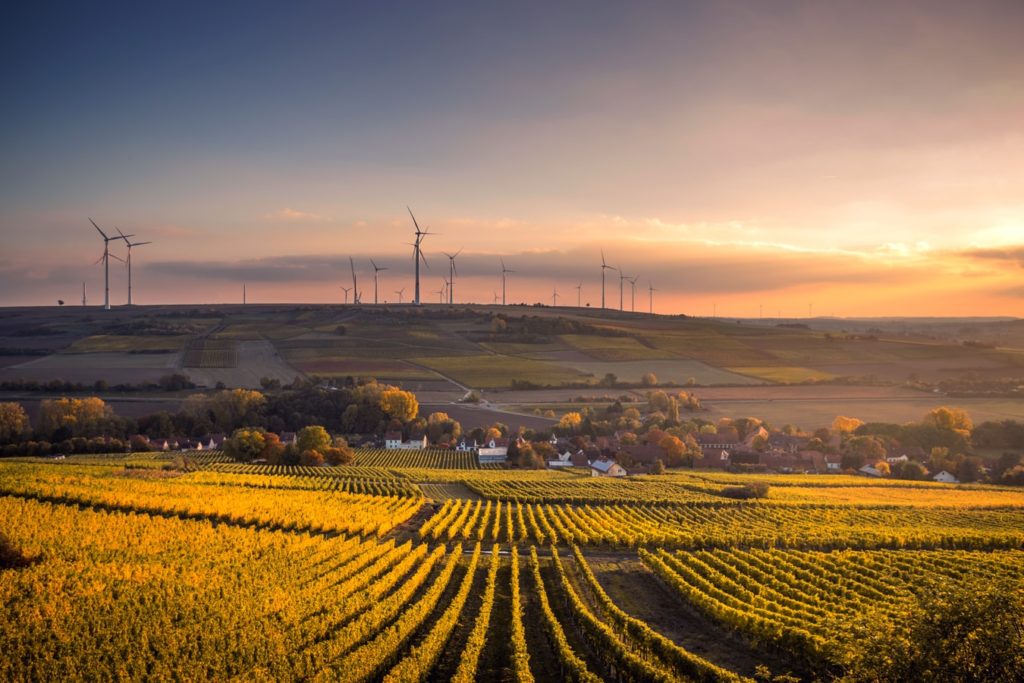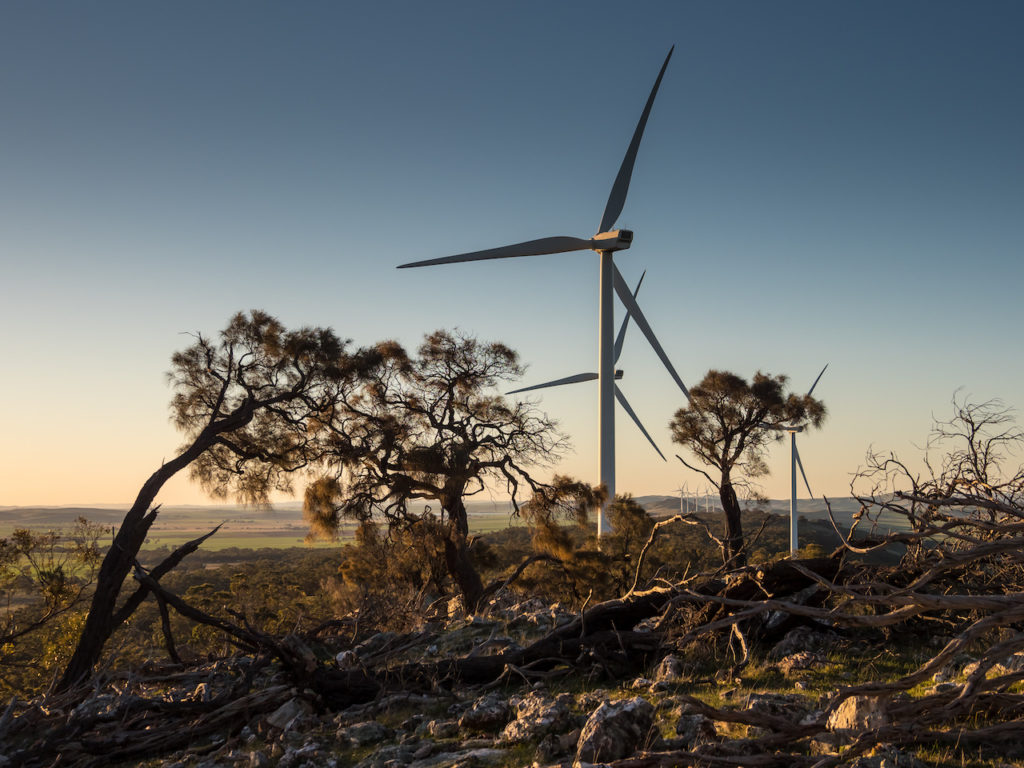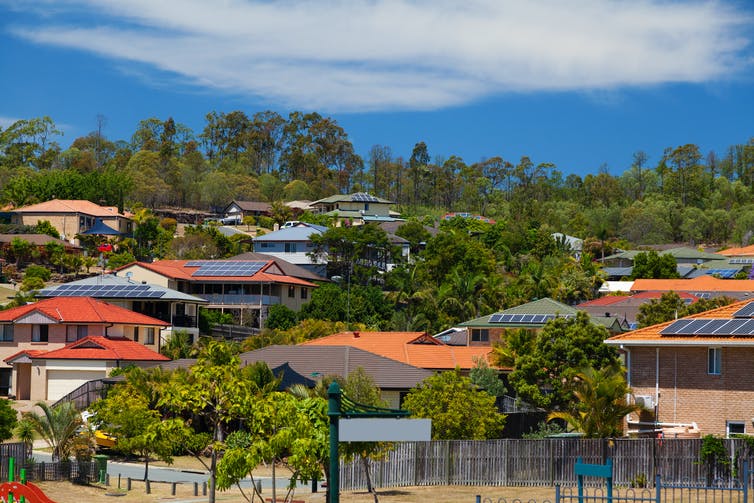
Where do Australia’s major
parties stand on climate action?
Australian Political Party Platform Analysis – 2022 Federal Election
Curious as to where the three largest political parties in Australia stand on climate action?
Look no further! The Federal Election is less than two weeks away and many Australians will be headed to the ballot box with climate in mind. We’ve summarised the climate policies of the Liberal National Party (LNP), Australian Labor Party (ALP) and the Australian Greens (Greens) so you can vote in the 2022 federal election armed with the facts. The policies are collated from each party’s website, without Climate Council commentary.
On this page, you will find…
- Some example questions to ask yourself when thinking about climate policies
- A table outlining the relevant climate policies of the major political parties
- A summary of the Climate Council’s climate action policies that we are advocating for at a federal level
When considering any candidate’s or party’s policy, it’s helpful to ask yourself the following questions:
- Does the policy rely on proven zero-emissions technology (such as solar energy, or wind energy – either on or offshore)? Or, does it gamble on unproven technologies such as Carbon Capture and Storage (CCS)?
- Does the policy discourage or encourage companies to keep polluting? For example, policies that rely on carbon credits and offsetting are, most of the time, ineffective at reducing emissions.
- For a full list of questions you can consider when interrogating climate policies, click here.
Climate and energy policies of the major political parties 2022
Note: scroll across to reveal the whole table when viewing on mobile
| POLICY AREA | LNP | ALP | GREENS |
| National Greenhouse Gas Emissions Reduction Target (below 2005 levels) | 26-28% by 2030 | 43% by 2030 | 75% by 2030 |
| Net Zero Emissions 🌿 | Net zero by 2050 | Net zero by 2050 | Net zero by 2035 |
| Coal ⚫️ | Committed to the continuation of Australia’s coal and gas export industries through to 2050 and beyond. The LNP’s own modelling of the electricity grid factors in the continuing use of coal and a significant proportion of gas in the electricity grid in 2050. | Will approve new coal mines that meet environmental standards. No plans to phase out Australian coal production for export. | Immediately ban the construction of new coal, oil and gas infrastructure. Phase out the mining, burning and export of thermal coal by 2030. Stop subsidies to coal, oil and gas corporations – collectively worth $10 billion each year – and reinvest this money into the clean energy transition. Ban all political donations from the mining and resources sector. Stop Resource Ministers and advisers from working for the fossil fuel industry within five years of leaving Parliament. Improve transparency through a register of meetings between Ministers and mining lobbyists. |
| Gas ⛽️ | Promotes a “Gas-fired recovery” from covid-19, which focuses on increasing the production of polluting gas. | No plans to phase out gas production. Considers gas a “transition fuel.” There is little detail available on the future of Australia’s gas export industry in the ALP’s published energy and climate plans. | See above. |
| Renewable Energy ☀️ | No target. Invest $84 million in microgrids for remote communities. | Install 85 solar banks, targeting 25,000 households previously locked out of rooftop solar. This co-investment of $100 million aims to catalyse further private investment in community solar banks. Invest $200 million to install 400 community batteries across Australia, with each battery servicing 250 households. Modelling commissioned by ALP shows the Powering Australia Plan will increase the share of renewable energy in the national electricity market to 82% by 2030. | Transition to 100% renewables rapidly. Large-scale public investment in renewable energy and storage to replace every coal-fired power station in the country by 2030. Creation of a publicly-owned, non-profit power retailer in order to push power prices down and end price gouging by major energy companies. Implement a $235 million “electrify everything” pilot program in both a suburb and a regional town. The pilot wiould see homes and businesses provided with solar and batteries, replace gas and an EV to demonstrate the benefits of a suburb or town wide installation. |
| Transmission Infrastructure ⚡️ | No comprehensive transmission infrastructure plan. The LNP Government has supported or underwritten investment in (rather than directly financed) more than $2.6 billion across new transmission projects. | Modernise and extend Australia’s ageing energy grid through the $20 billion plan to Rewire the Nation. | A $25 Billion FutureGrid fund to enable the rewiring of Australia, upgrading and building new publicly owned transmission lines and interconnectors linking up renewable energy zones in line with the market operator’s Integrated System Plan. |
| Clean Energy Exports ⚡️ | The Morrison Government is investing more than $1.2 billion in Australia’s hydrogen industry, which includes both fossil fuel-powered and renewable-powered hydrogen projects. | Support the development of new clean energy industries, such as renewable hydrogen production and export, and bioenergy via the Powering the Regions Fund. | Invest in new export industries in renewable hydrogen and minerals processing. |
| Clean manufacturing, heavy industries and powering the regions ⚙️ | The Long Term Emissions Reduction Plan includes investment in green steel and alumina. Support the early design of hydrogen hubs, of which an estimated $30 million is available for Hydrogen Hub Development and Design Grants. Hydrogen projects will be powered by either fossil fuels with Carbon Capture and Storage (CCS) or renewable energy. | Invest up to $3 billion from Labor’s National Reconstruction Fund in green metals (steel, alumina and aluminium); clean energy component manufacturing; hydrogen electrolysers and fuel switching; agricultural methane reduction; and waste reduction. Support industry to decarbonise through energy efficiency improvements and fuel switching (e.g. hydrogen) as well as seeding new clean energy industries, including renewable hydrogen production and export, and bioenergy. The ALP’s Powering Australia Plan refers to green hydrogen (powered by renewable energy) and hydrogen (which could be powered by either renewables or fossil fuels). | Establish a $12 billion Manufacturing Australia Fund to help local manufacturers recover from the pandemic, move off coal and gas and expand into new sectors. Use low cost, renewable energy to rebuild Australia’s manufacturing industry, support new green export industries and bring back jobs that have gone overseas. Implement a Buy Local, Buy Green scheme to ensure the Government is buying products made by local workers produced with clean, green materials and power. |
| Critical Minerals ⛏ | The Morrison Government’s 2022 Critical Minerals Strategy aims to grow Australia’s critical minerals sector. Further, the Government has committed $200 million to the Critical Minerals Accelerator Initiative to support strategically significant projects at challenging points in their development. | Invest in Australia’s critical minerals processing capability via the $1 billion value-Adding in Resources Fund, as part of the $15 billion National Reconstruction Fund. | Investment in new minerals processing. |
| Transition for Fossil Fuel Workers 👷🏾♂️ | No dedicated planning for transitioning fossil fuel workers. | Commit $100 million to support 10,000 New Energy Apprenticeships and $10 million in a New Energy Skills Program. | Create good long-term jobs, reskilling workers into similar industries, and provide grants to help new employers get off the ground. Create long term, sustainable industries to assist in the move beyond fossil fuels and to ensure people do not lose work. |
| Agriculture and Land Management 🌱 | Ahead of the 2019 election, the LNP announced a top up of $2 billion dollars for the Emissions Reduction Fund. This scheme funds emissions reductions projects in the land sector, waste and industry. To date, less than one tenth of this committed funding has been allocated to projects. | Support Australian agriculture, fisheries and forestry industries to capitalise on their economic and employment potential. Provide $10 million each year to double the number of Indigenous rangers. | End land clearing and native forest logging to protect the carbon already in native forests and grasslands. Create local forestry jobs through planting trees and restoring damaged forests and habitats. Work with farmers to increase carbon sequestered on land, drawing down pollution while providing new revenue streams for farms. Increase funding to Indigenous ranger programs. |
| Transport 🚗 | Install 400 public fast charging stations for EVs across Australia, via the Future Fuels Strategy. The fund will also cover smart charging at home, hydrogen refuelling infrastructure, and additional fast charging stations in metropolitan and regional areas. The most recent budget includes new commitments for funding: Faster rail between Brisbane and the Sunshine Coast; and Sydney to Newcastle. Perth’s METRONET public transport system. | Introduce a $500 million Driving the Nation fund, enabling investment in additional EV chargers – as well as hydrogen and biofuels refuelling infrastructure. Implement a National EV Charging Network to establish EV charges approximately every 150km across major roads. Develop Australia’s first National Electric Vehicle Strategy, complemented by the Electric Car Discount. This initiative will ensure many EVs are exempt from the 5% import tax and the 47% fringe benefits tax (available to EVs under $77,565). Create a national Hydrogen Highways refuelling network, delivering up to 16 hydrogen stations across Australia’s busiest freight routes. Implement the National Rail Manufacturing Plan, including a plan for more trains to be built in Australia by local manufacturing workers, as well as a fast rail between Sydney and the Hunter. | Rebates to reduce the cost of an electric vehicle by up to $15,000 with low interest finance available for the balance. Build a $2 billion publicly-owned EV fast charging network. Electrify the entire Commonwealth fleet by 2025, which will help create a larger second-hand vehicle market. End the sale of new petrol and diesel cars from 2030. Legislate comprehensive vehicle pollution standards to drive down emissions. Allocate $1.2 billion to manufacturers of electric vehicles and electric vehicle components in Australia to build the Australian EV manufacturing industry. An extra $25 billion into rail and bus services and $500 million per year into making cycling and walking safer and more accessible, and connecting people from the cities to outer suburbs and regions with ease. Thousands of new electric buses. Build high speed rail from Melbourne to Brisbane, giving people an alternative way to travel domestically. Invest in getting more freight onto rail and reducing truck fleet pollution. |
| Price on Carbon 💰 | No policies. | Undertake a short review into Australian Carbon Credit Units (ACCUs) to ensure their integrity, consistency with agricultural and other objectives, and contribution to environmental, economic and other benefits like biodiversity. | Implement a carbon price and levy on exported climate pollution. |
| Great Barrier Reef 🐠 | An additional $1 billion towards the Reef 2050 Long-Term Sustainability Plan to improve water quality, fighting crown of thorns starfish and conducting research into reef restoration and adaptation. In 2018, the LNP Government signed the $443.3 million Great Barrier Reef Foundation (GBRF) contract without tender to be spent over six years. Since 2018, approximately $363.3 million of the funds have been committed to ten regional programs. | Commit $85 million to scale up ‘shovel-ready’ work for coral to coast reef resilience and land restoration projects. Allocate $15 million to permanently secure the Centre for Marine Ecosystems Research site on Gladstone’s marina, scale up its research operations, and scale up its application of that research in partnership with Indigenous sea rangers. Commit $63 million for the Reef 2050 program over the forward estimates and ensure funding continues to the end of the decade. Terminate the $443.3 million GBRF contract, and reallocate unspent funds to Reef conservation, while retaining worthwhile programs. | Improve Reef water quality with a $2 billion grant fund over 10 years available to scientists, governments and farmers to improve farming practices and repair reef catchments, and setting legal caps on water pollution by catchment. Reclaim the balance of the $443 million grant made to the Great Barrier Reef Foundation, and reallocate the funds through an updated grants process for Reef funding. Strengthen the Great Barrier Reef Marine Park Authority and the Australian Institute of Marine Science with $90 million in extra funding, greater independence and stronger powers including regulating coastal development. Stop coal and gas port expansions including at Abbot Point, Fitzroy Delta and Cape York Peninsula. Ban all offshore dumping of dredge spoil. Address illegal fishing and overfishing, including ending hammerhead shark fishing. |
| Climate change-related Institutions 🎓 | No policies. | Restore the role of the Climate Change Authority (CCA), ensuring the CCA provides guidance on future emissions reduction targets, and delivers annual reports on progress against national targets and international developments. Funding for this policy has not been specified. | Resource the Climate Change Authority (CCA) and remove former coal and gas executives. Task the CCA with: – conducting a national security assessment of the impacts of the climate crisis on Australia – advise the National Climate Action Taskforce on eight net zero plans for each sector of the economy – develop a negative emission drawdown program post-2035. – preparing for the impacts of the climate crisis that we cannot avoid as a result of the warming that has already occurred and is baked into earth’s climatic systems. Restore ARENA’s funding cuts, investing $500 million in the first year of the forward estimates. Revise the mandate of the Export Finance and Insurance Corporation and Clean Energy Finance Corporation to facilitate support for the development of renewable energy exports and High Voltage DC transmission cables and hydrogen fuel exports into Asia. |
| Energy Efficiency / Energy Productivity 🔌 | Implement a new $60 million Powering Business program, offering grants of up to $25,000 to small businesses, and up to $50,000 matched funding for medium businesses to support energy efficient equipment upgrades. | Support businesses to adopt energy efficiency measures via The Powering the Regions Fund. Further, upskilling workers for energy efficiency upgrades to homes and businesses through the New Energy Apprenticeships program. | A National Energy Efficiency Target Scheme to place an obligation on energy retailers to drive energy efficiency improvements across households and businesses. The Green’s modelling shows that this plan (coupled with their economy-wide price on carbon) would double energy productivity by 2030. |
| Climate Resilience 💪🏽 | Boost the Black Summer Bushfire Recovery Grant Program by $116.4 million. | Provide $200 million per year on disaster prevention and resilience. Conduct a Climate Change & Security Risk Assessment. Implement a Disaster Readiness Plan that will: Fully fund disaster recovery through the existing Disaster Recovery Funding Arrangements Cut red tape so disaster resilience funding can get out the door faster Improve the efficiency of disaster recovery processes, to simplify and speed up payments to disaster victims and repairs to damaged infrastructure. Assist with spiralling insurance premiums in disaster-prone regions, by reducing the risk of expensive damage to homes and businesses. | Legislate to make fossil fuel companies pay to clean up their mess, and reinvest those funds in infrastructure – such as floodproofing stormwater drains, to improve the capacity of transport systems to handle heatwaves. Double the current funding for Emergency Service operations, providing $5 billion in extra funding allocated to the States. |
If you want to know more about the Federal Government’s record on climate change since the election of the Liberal-National Coalition in 2013, then our report Lost Years: Counting the costs of climate inaction in Australia provides a detailed overview.
A summary of the Climate Council’s policy position 👇🏽
The Climate Council has published its own comprehensive list of climate action policies which we are advocating for at a federal level. Here’s a summary of our policy positions!
National Greenhouse Gas Emissions Reduction Target (below 2005 levels)
- 75% by 2030.
Net Zero Emissions
- Net zero by 2035.
Establish Australia as a climate leader
- Expand the transmission network to enable Australia to achieve 100% renewable electricity.
- Reform the National Construction Code and lock-in a 2025 review to continue improving standards.
- Upgrade Australia’s ageing homes – roll out a national energy efficiency upgrades program. 9.5 million homes were built before energy standards came into effect.
- Replace fossil fuel cars with electric vehicles with a national strategy that has a target to end new sales of fossil-fuel cars and rigid trucks by 2030.
- Ensure half of all transport funding goes towards public transport, with an additional $500m every year for cycling and walking infrastructure.
- Support local manufacturing of clean infrastructure with a strategy for local manufacturing of clean technologies, including wind turbines and electric buses.
- Make regional communities and public buildings clean energy hubs via establishing community-owned clean energy hubs.
- Invest in research and development of emerging agricultural technologies.
- Promote clean energy exports such as green steel, green aluminium, renewable hydrogen – as well as exports of minerals such as nickel, copper, lithium and cobalt that are critical to the development of batteries, solar panels and electric vehicles.

Prepare Australia for worsening extreme weather
- Accept that the Australian Government has an important role to play in disaster response coordination.
- Develop a National Coastal Strategy.
- Urgently implement all findings of the Royal Commission into National Natural Disaster Arrangements.
- Develop a national adaptation plan.
- Ensure federal bodies incorporate climate risks into their objectives.
- Provide more funding for disaster resilience.
- Properly resource local governments to prepare for worsening extreme weather.
- Undertake an Integrated Climate and Security Risk Assessment.
- Properly model the costs of climate change impacts regularly.
- Prepare critical infrastructure for extreme weather.
Improve existing energy policies
- Reform the Environment Protection and Biodiversity Conservation (EPBC) Act.
- Commission an independent review of the Emissions Reduction Fund.
- Support the establishment of the offshore wind industry.
- Wholesale audit of the safeguard mechanism to align with net zero emissions.
- Implement real-time monitoring of emissions at fossil fuel facilities.
- Refresh and re-invest in the Clean Energy Finance Corporation (CEFC) and the Australian Renewable Energy Agency (ARENA).
End government support for fossil fuels
- No taxpayer subsidies for fossil fuels.
- No new taxpayer subsidies for carbon capture and storage (CCS).
- Suspend the annual offshore petroleum acreage release.
- Introduce a moratorium on new offshore gas production.
- Reverse changes to ARENA’s mandate via regulation.
- Terminate the Underwriting New Generation Investment (UNGI) Program and abandon the Grid Reliability Fund.
- End public funding for fossil fuel infrastructure and exploration overseas.
- Phase out the fuel tax credit scheme.
- Bilateral energy agreement reforms to include emissions reduction.
- Reform the Northern Australia Infrastructure Facility (NAIF) to explicitly ban it from investing in new fossil fuel infrastructure.
- Proper engagement with communities at the forefront of the energy transition.
Strengthen transparency and accountability
- Restore the independence of the Climate Change Authority.
- Increase funding to CSIRO and the Bureau of Meteorology (BOM) to restore confidence in their climate research.
- Increase accountability of the National Recovery and Resilience Agency (NRRA).
- Establish an independent body to research gas industry emissions.
- Terminate the Great Barrier Reef Foundation funding agreement.
- Replace the Technology Investment Advisory Council.
- Refresh the Clean Energy Regulator.
Reposition Australia as a trustworthy international ally
- Strengthen our Nationally Determined Contribution (NDC) at COP27.
- Immediately increase Australia’s overall contribution of international climate finance to AU$3 billion over 2020-2025 and resume contributions to the Green Climate Fund.
- Establish a position of Climate Change Ambassador within the Department of Foreign Affairs and Trade.
- Bid to host the annual Conference of Parties to the United Nations Framework Convention on Climate Change as soon as possible.
- Work closely with Pacific Island countries to promote climate action.
- Host an Indo-Pacific clean energy forum.
- Help Indonesia accelerate its move away from coal.
- Work closely with key security allies on climate action.
For more detail, check out the Climate Council’s Climate Policies For a Sensible Government.
| Disclaimers We couldn’t pack every single relevant policy onto this web page so check out each party’s website if you’re after a more detailed list. – For all the ALP’s climate policies, click here. – For all the Australian Greens’ climate policies, click here. – For all the LNP’s climate policies, click here. With a large number of independent candidates and minor parties running in this election and limited resources, we have restricted our analysis to the three largest political parties. The Climate Council does not offer endorsements of policies or political parties. Rather, we assess each policy or position against the best available science and expert advice. |
Authorised by Amanda McKenzie, Climate Council of Australia Ltd, Sydney.

